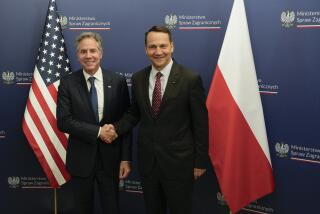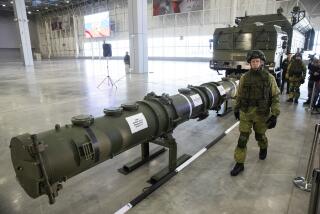Movement on Arms Control
The United States, in rounding out its negotiating position on the removal of medium-range missiles from Europe, has proposed on-site inspection requirements going far beyond anything included in past arms-control treaties. There is some suspicion that the Administration is using the verification issue to stonewall an agreement, secure in the belief that the Soviet Union would reject anything so far-reaching. But the fact is that the Soviets have been saying that they want tough verification requirements, too. If the U.S. proposals were to be accepted in anything like the form laid out by Washington, the agreement could mark a historic milestone in arms control.
Moscow and Washington have submitted proposals at the Geneva arms-reduction talks under which both would remove all their medium-range missiles from Europe but be allowed to deploy an aggregate of 100 warheads aboard medium-range missiles in Soviet Asia and mainland America. The remaining barriers to an agreement are the handling of short-range missiles, in which the Soviets have a major advantage, and the working out of verification measures.
The verification package unveiled last week in Washington would forbid the encoding of telemetered data from missile tests and require the exchange of comprehensive information about the missiles and launchers covered in the agreement, the specific location of the missiles bearing the 100 allowable warheads, and agreed-on procedures for the destruction or dismantling of the missiles removed in Europe or their conversion into weapons that would not violate the treaty.
Most important of all, the U.S. proposal provides for on-site monitoring of missile destruction or dismantling, as well as on-site inspections of missile factories and bases to ensure compliance with the agreement. Inspections for suspected violations could be demanded by either party. U.S. officials say informally that up to 200 inspectors on each side could be involved.
Some experts question whether intrusive on-site inspections are really necessary, but Richard N. Perle, the hard-lining assistant defense secretary who will soon leave his Pentagon post, denies any Administration ploy to block an agreement by making unrealistic verification demands. We hope that is true; judgment must await the give-and-take of negotiations.
On-site inspections, which the Soviets have traditionally resisted, could help avoid the kind of squabbling over compliance that surrounded the SALT II treaty. And there are signs of a softening in Soviet objections to on-site inspections. In recent days Soviet officials have suggested that Moscow is even more adamant than Washington in wanting such inspections on the territory of the other power. We hope that they mean it.
Soviet acceptance of the full verification package has to be considered unlikely. In fact, it is hard to believe that either power wants inspectors from the other side free to prowl around any installation where they claim they might find evidence of violations. Provided that both sides are serious, however, it may be possible to strike a deal that will set an extremely helpful precedent for a wide spectrum of arms-control negotiations.
More to Read
Sign up for Essential California
The most important California stories and recommendations in your inbox every morning.
You may occasionally receive promotional content from the Los Angeles Times.










